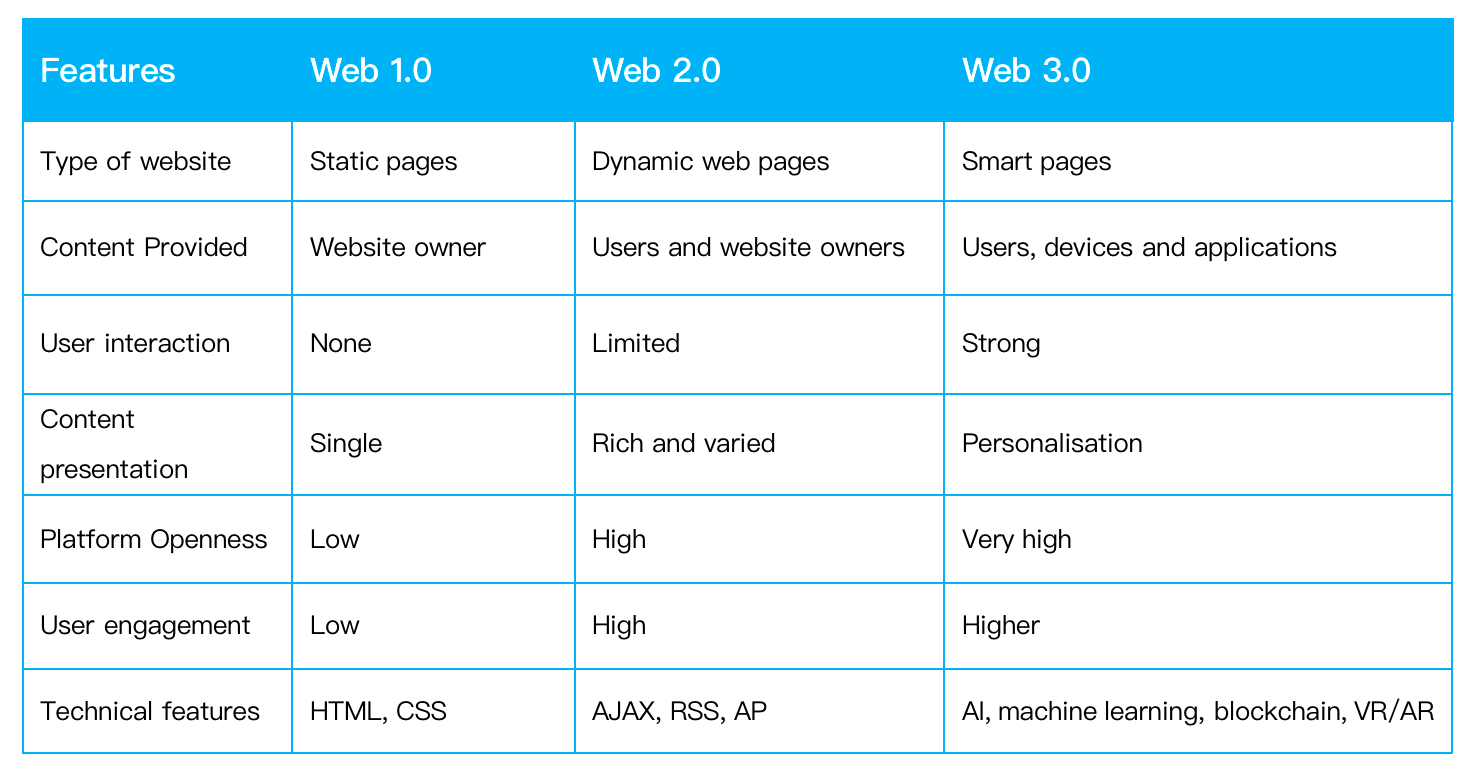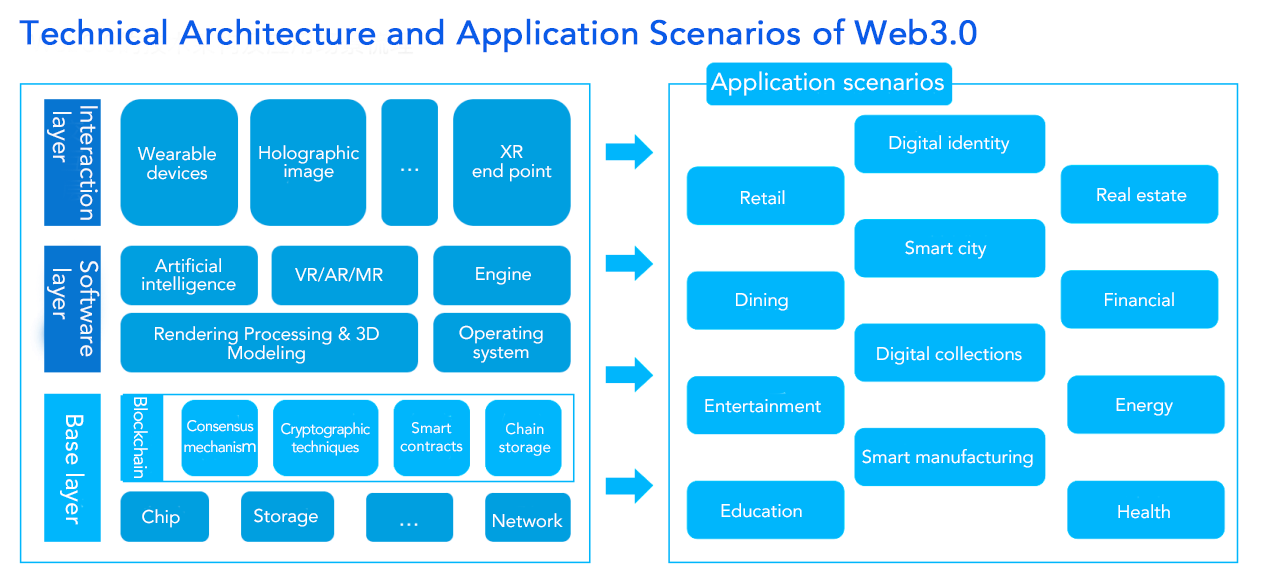Abstract: The emergence of Web3 has brought a significant transformation in the Internet landscape, enhancing its security, transparency, openness and fairness. This paradigm shift has not only improved efficiency but also revolutionized traditional business models, offering improved solutions in key areas such as digital asset trading, data sharing and identity management.
Main article content
How does Web 3.0 differ from Web 1.0 and Web 2.0?
What new changes does Web3 bring to the table?
Application scenarios and trends of Web3
ChainUp's presence in the Web3 space
Web 3.0, is the evolutionary stage of development of the Internet, also known as the Internet of Value or the Decentralised Internet. The evolution of Web3 can be traced back to Satoshi Nakamoto's Bitcoin white paper published in 2008. The success of Bitcoin facilitated the development of blockchain technology, followed by the emergence of smart contract platforms most notably by Ethereum, which enabled developers to create more complex decentralised applications. The concept of Web3 also emerged, signaling that blockchain technology would have a major impact on the future of the Internet.
How is Web 3.0 different from Web 1.0 and Web 2.0?
Unlike Web 1.0 and Web 2.0, Web 3.0 is focusses on decentralised technology and blockchain technology, which combines artificial intelligence (AI), the Internet of Things (IoT) and cryptography to create a new type of Internet ecosystem.
The Web 1.0 era was the beginning of the Internet, when websites consisted mainly of static web pages and users could only passively view the information on the web pages, lacking interactivity. The Web 2.0 era signifies a dynamic and engaging phase in digital interaction. It empowers users to contribute in website development and content creation, transforming websites into personalized and interactive platforms. Web 3.0 is an evolution of Web 2.0 that emphasises decentralisation and the application of blockchain technology, transforming the Internet from centralised to decentralised.
In Web 3.0 data and applications are no longer controlled and managed by a single central organisation or company, but by a distributed network and smart contracts. It allows users to participate directly in the network and collectively manage & control data as well as applications enabling more democratic, fair and transparent Internet.
Key features of Web3:
1. Decentralisation: Instead of a single centralised institution or company controlling and managing data and applications, Web3 is controlled by a distributed network and smart contracts, enabling a more democratic, fair and transparent Internet.
2. Blockchain Technology: Decentralisation in Web3 relies on blockchain technology to enable distributed management, control of data and applications through decentralised networks and smart contracts.
3. Smart Contracts: Web3 uses smart contract technology that can be executed without third-party intervention, enabling a variety of complex operations and tasks such as digital identity verification, digital asset management etc.
4. Cryptography & Security: Web3 uses cryptography to allow users to own and manage their own data as well protect its privacy and security.
Comparing Web 1.0, Web 2.0 and Web 3.0

In general, websites in the Web 1.0 era mainly provide information from the website owner and the users could only browse passively, lacking interactivity. Websites in the Web 2.0 era focused more on user interaction with more open platforms and richer diverse content. Websites in the Web 3.0 era focused more on intelligence and personalised services, using technologies such as artificial intelligence, machine learning and blockchain making websites more intelligent, providing more personalised services and experiences.
What transformative changes does Web3 bring to the table?
Today's Internet has been decades in the making while bringing greater convenience it has also revealed many problems and challenges. The centralized Internet architecture, especially in the hands of big tech companies, compromises data privacy and security. This raises concerns about unauthorized access, breaches, and misuse of personal information and even possible unfairness in the resource allocation of the internet. As user data is stored centrally on the servers of a few large technology companies, there is a risk of commercial exploitation and abuse of power. Moreover, centralised Internet architectures are susceptible to hacking and technical failures, leading to issues like data loss and disruption of business services.
The emergence of Web3 presents a promising solution. Wbe3 aims to create a more secure, transparent, open, fair and more efficient Internet. It address the limitations of traditional models by revolutionizing areas such as digital asset trading, data sharing and identity management. The impact of Web3 can be observed in three ways:
1. Distributed network and decentralisation: Web3 harnesses the power of distributed ledger technology to establish a permissionless, trustless and decentralised network. By storing data in multiple locations, it reduces reliance on centralised databases. This approach mitigates the risk of hacking and data breaches through verifiable data scarcity and tokenized virtual assets. For instance, smart contracts and asset tokenization technology can better protect and manage digital copyrights, eliminating intermediaries and simplifying copyright maintenance. Furthermore, tokenised virtual assets offer creators, such as artists and game developers additional revenue streams and a fairer, more transparent distribution mechanism.
2. Data privacy and ownership: Web3 introduces improved mechanisms for data privacy and ownership protection, enabling users to grant access to their data without revealing any sensitive information through smart contracts.
However, in a Web3 architecture, social media platforms can be built on a distributed network, offering enhanced data privacy and ownership protection. Users can leverage smart contracts and decentralized storage to share their posts, ensuring that their data remains under their control while granting selective access to other users. By leveraging on Web3, individuals can regain control over their personal data and ensure that it is shared securely, revolutionizing the way data privacy and ownership are managed in the digital landscape.
3. Openness and interoperability: The openness and interoperability of Web3 enables seamless connectivity and interaction among different applications and platforms, irrespective of the underlying blockchain technology or protocol they are built upon. This will facilitate boarder collaboration and innovation, leading to enhanced functionality and services, regardless of the differences between them. For instance, if a digital asset wallet application can seamlessly interact with various blockchain networks and protocols. In such a scenario, users will be able to manage and use multiple different digital assets within a single application, eliminating the need to download and use multiple applications for different assets. Such interoperability significantly improves the user experience, reduces barriers to usage and increase the popularity of digital assets.
In addition, Web3 offers many emerging business models, such as decentralised applications, digital assets and smart contracts paving way for up more opportunities and innovation.
Application Scenarios and Trends of Web3
At present, the application scenario of Web3 has gradually expanded to a number of fields including decentralised finance, digital identity authentication, digital art trading, non-homogeneous tokens, gaming, artificial intelligence, etc.
l Decentralised Finance (DeFi): Web3 can be used to develop decentralised financial applications such as decentralised exchanges, lending platforms, stablecoins and insurance. These applications can provide more secure, transparent and efficient financial services while also changing the business model of traditional financial institutions.
l Digital Identity Authentication: Web3 can be used for digital identity authentication, where users can create their own digital identity and use smart contracts to implement it. This technology helps increase the security and trustworthiness of the identity while protecting the user’s privacy and data security.
l Digital Art Trading: Web3 can be used to develop a digital art trading marketplace, where artists can digitise their artwork and use blockchain technology to enable the ownership and trading of artwork. This technology can increase the transparency and security of art transactions while providing better creative and commercial opportunities for artists.
l Non-Homogenous Tokens: Web3 provides a more secure, decentralised, transparent and autonomous solution for the trading and circulation of NFTs through technologies and tools such as blockchain, smart contracts, digital assets, wallets, NFT marketplaces and metadata standards. It enables NFTs to be accurately identified and tracked, protecting the uniqueness and irreplaceability of NFTs, while making it more convenient and efficient to trade and circulate NFTs.
l Gaming: Web3 can use blockchain technology and smart contracts to implement a decentralised gaming platform and a virtual item trading platform for a fairer and more transparent gaming ecosystem and to better protect the rights of gamers.
l Artificial Intelligence: Web3 uses blockchain technology to protect the intellectual property and privacy of AI algorithms, while also enabling a decentralised marketplace for AI algorithms, providing a transparent opportunity and platform for AI developers and users.
Web3 has many other potential applications and business values due to its decentralisation, high transparency and data autonomy. The development of blockchain technology and smart contracts will also drive continuous innovation in Web3 application scenarios. In addition to the several application scenarios mentioned above, it can also be applied to healthcare, data markets, social networks, the sharing economy, IoT, supply chain finance, energy and other areas. With the continuous development and innovation of Web3 technology, the application scenarios of Web3 will continue to expand and deepen in the future.

Although the concept and technology of Web3 has been in existence for some time, it is still in its early stages of development. Firstly, the technology underlying Web3 is still evolving and undergoing refinement. While most Web3 applications are currently built on blockchain technology, there are limitations to the scalability, transaction speed and cost. Second, the user base for Web3 applications remains relatively small. Although awareness of the Web3 concept and technology is increasing, only a minority of individuals are actively using and participating in Web3 applications. This can be attributed to the steep learning curve associated with Web3 applications and the lack of user-friendly tools and interfaces. The legal and regulatory environment surrounding Web3 applications is still uncertain in many countries. Regulatory policies regarding Web3 are currently inconclusive and require further discussion and research. ChainUp is also constantly exploring and refining our presence in the Web3 space.

Photo credit: a16zcrypto
ChainUp's presence in the Web3 space
ChainUp has been deeply involved in the blockchain and Web3 sectors for many years, establishing a relatively sound ecological framework. Specifically, ChainUp has focused on the following 3 key areas:
1. Node Infrastructure: ChainUp provides a full node API through the ChainUp Cloud platform, enabling users to easily operate and manage nodes. Additionally, our white-label verifier service is available to help users to pledge public verifiers for multiple chains with a single click.
2. Liquidity Pledge: As a member of NodeDAO, ChainUp Cloud provides liquidity pledge products tailored for node operators including digital assets such as ETH, Filecoin, ADA, MINA, ATOM and EOS, to meet the liquidity needs of node operators and support them in more robust operations.
3. Wallet Infrastructure: ChainUp Custody provides MPC (Multi-Party Computation) wallet hosting solutions to provide users with secure and reliable wallet management and trading services, helping users to manage and trade digital assets more securely.
ChainUp's design and services in the area of Web3 fully reflect its knowledge and understanding of Web3 technology providing users with comprehensive support to help them better enjoy Web3 services.